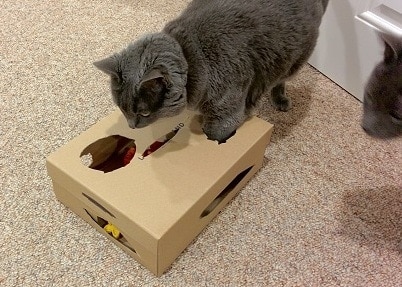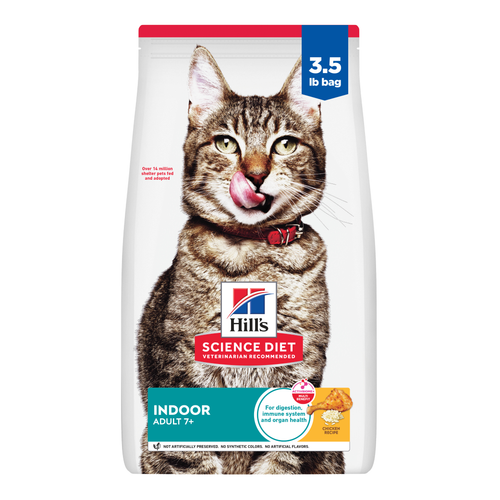
-
Find the right food for your petTake this quiz to see which food may be the best for your furry friend.Find the right food for your petTake this quiz to see which food may be the best for your furry friend.Featured products
 Adult Large Breed Chicken & Barley Recipe Dog Food
Adult Large Breed Chicken & Barley Recipe Dog FoodSupports healthy joints, lean muscle, and beautiful coat for large breed dogs
Shop Now Adult Chicken & Barley Recipe Dog Food
Adult Chicken & Barley Recipe Dog FoodSupports lean muscle and beautiful coat for adult dogs
Shop Now Hill's Science Diet Adult Chicken & Beef Entrée Dog Food
Hill's Science Diet Adult Chicken & Beef Entrée Dog FoodChicken & Beef Entrée in a delicious loaf with complete & balanced nutrition to help keep adult dogs active and healthy
Shop NowFeatured products Adult Tender No Corn, Wheat, Soy Chicken & Vegetables Stew Cat FoodShop Now
Adult Tender No Corn, Wheat, Soy Chicken & Vegetables Stew Cat FoodShop Now Adult Turkey & Liver Entrée Cat Food
Adult Turkey & Liver Entrée Cat FoodPrecisely balanced nutrition with the delicious taste of minced turkey & liver to help fuel the energy needs of cats during the prime of their life
Shop Now Senior Vitality Adult 7+ Tuna & Vegetables Stew
Senior Vitality Adult 7+ Tuna & Vegetables StewImproves Everyday Ability to Get Up & Go
Shop Now -
Dog
- Dog Tips & Articles
-
Health Category
- Weight
- Food & Environmental Sensitivities
- Urinary
- Digestive
- Joint
- Kidney
-
Life Stage
- Puppy Nutrition
- Adult Nutrition
- Senior Nutrition
Cat- Cat Tips & Articles
-
Health Category
- Weight
- Skin & Food Sensitivities
- Urinary
- Digestive
- Kidney
-
Life Stage
- Kitten Nutrition
- Adult Nutrition
Featured articles What Is Littermate Syndrome? Pet Adoption Guide
What Is Littermate Syndrome? Pet Adoption GuideLearn more about littermate syndrome in dogs and cats and how to successfully navigate adoption and early socialization processes.
Read More The Science Behind Our Love for Pets
The Science Behind Our Love for PetsLearn the scientific reasons why we have such strong connections with our pets, and what science says about the love between humans and our furry friends.
Read More How to Properly Mix Wet & Dry Pet Foods
How to Properly Mix Wet & Dry Pet FoodsAn Orange cat eating from a bowl filled with mixed food
Read More -


If you're a pet parent who's also a human parent, you already know that your fur baby loves your kid's toys. But did you know that once your child outgrows his or her playthings, you can easily repurpose them into fun, fabulous homemade cat toys?
Your home is a gold mine of potential DIY cat toys! Begin by surveying your toy collection with a fresh eye. What can you safely turn into a new toy for your kitty? Stuffed animals are a good start, and your feline friend already has a keen interest in them. Cut off any long whiskers, plastic eyes, and other hazardous materials, and you're good to go!
As Vetstreet points out, it's important to keep safety concerns in mind when transforming kids' toys into pet toys. "With plush toys," it warns, "avoid fillings such as polystyrene beads, nutshells, or beans." You also need to be mindful of batteries (always remove them) and materials such as ribbons, strings, yarn, or feathers, because they can harm your cat if ingested.
Also, avoid giving your cat wooden toys, especially ones that are painted. Cats are chewers and could ingest wood splinters or paint, neither of which is good for her health.
Cats also love anything round, so let her have full access to any old sports balls lying around the home. But, be sure that none of them are small enough to be ingested. Indoor play tents are another good idea and make great sleeping nooks or hiding places for a sneaky cat.
Other DIY repurposed toy ideas include the following:
Cat Scratching Post Add-On

Bring new life to your cat's worn-out scratching post using interactive highchair toys, which are designed to keep a little one's interest and help develop his motor skills. These toys function the same way for kitties. Attach the toy so that its base is flush with the side of the post, then tightly secure with strong twine, trimming any excess string so your cat can't nibble on it.


Tasty Tips
Fast Food Toy Cat Teaser

More than likely, you have in your home a stash of small, plush animals from various fast food restaurants. Instead of donating or selling them at a garage sale, pass them on to your furry friend. With strong twine, wrap the animal securely around the end of a wooden dowel, and you'll have hours of fun with your kitty! The animals also work well as replacements for store-bought cat teasers. Because this toy contains a string, supervise your cat while she plays with the teaser, and keep it out of her reach when you're done.
Cat Puzzle Box

Homemade cat toys such as puzzle boxes are a great way to repurpose lots of different"pull-right" kids' toys. This idea calls for large-sized plastic building blocks (do not use any blocks small enough to fit in a cat's mouth) that hide in even the most remote corners of your living space. In addition to the blocks, you'll need a sturdy cardboard shoebox and a box cutter. Cut holes on the top and sides of the box, large enough so that your cat can see the colorful blocks inside and fit her paw through to grab at them. Leave the box top unsecured so that you can easily change out the toys (again, all toys should be larger than the cat's mouth and shouldn't contain any materials hazardous to your fur baby) and, for extra fun, sprinkle in some catnip.
Repurposing kids' toys into DIY cat toys is a great way to reduce clutter and waste and give playthings nine more lives.
Image source: Christine O'Brien


Christine O'Brien is a writer, mom, and long-time cat parent whose two Russian Blues rule the house. Her work also appears in Care.com, What to Expect, and Fit Pregnancy, where she writes about pets, pregnancy, and family life. Find and follow her on Instagram and Twitter @brovelliobrien.
Related products

Precisely balanced nutrition with the delicious taste of minced turkey & liver to help fuel the energy needs of cats during the prime of their life

Improves Everyday Ability to Get Up & Go


Supports energy level and beautiful fur in mature indoor cats
Related articles

Discover how to train your cat, starting with very basic first steps that both reward good behavior and discourage the bad.

Discover which cat toys games your feline friend might like, and how they are great sources of exercise. Explore our library of articles to learn more.

When you adopt a cat, you don't just gain a best friend; you also save her life. Here's why getting a cat from a local animal shelter makes so much sense.

Learn how to litter train a kitten with this guide to potty training, including when to start litter training kittens and troubleshooting tips.

Put your cat on a diet without them knowing
Our low calorie formula helps you control your cat's weight. It's packed with high-quality protein for building lean muscles, and made with purposeful ingredients for a flavorful, nutritious meal. Clinically proven antioxidants, Vitamin C+E, help promote a healthy immune system.
Put your cat on a diet without them knowing
Our low calorie formula helps you control your cat's weight. It's packed with high-quality protein for building lean muscles, and made with purposeful ingredients for a flavorful, nutritious meal. Clinically proven antioxidants, Vitamin C+E, help promote a healthy immune system.

